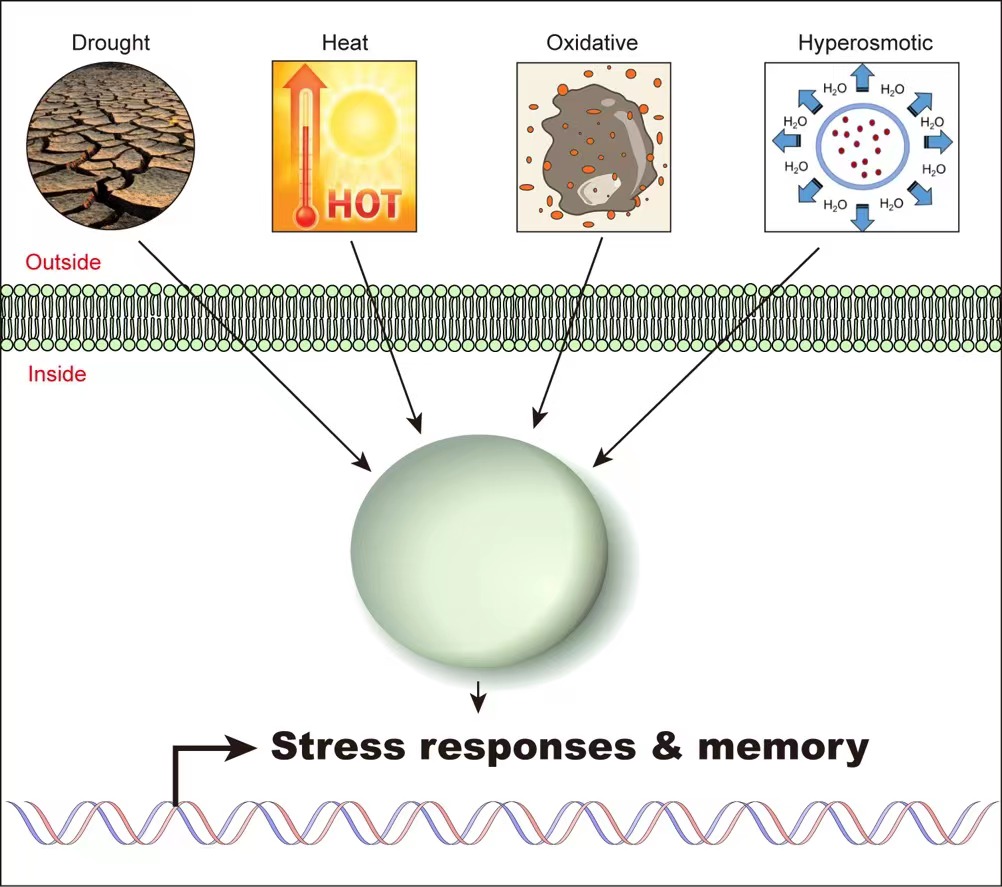Update date: 2025-09-12
真核细胞通过物理分隔来确保生化反应与细胞功能的效率与效能。无膜细胞器(membraneless organelle, MLO)是一类不依赖脂质膜的分隔方式,能够自发且快速地组装与解散,因此相较传统膜性细胞器具备独特优势。多数 MLO 由蛋白质和/或 RNA 通过液–液相分离(LLPS)组装而成【1】【2】。在典型真核细胞内,存在数量众多、在空间与时间上受限定位的 MLO(见图 1)。

植物由于不能迁移,必须快速应对光照、温度、水分等环境的持续波动。MLO 具备的可逆性、动力学特征与选择性使其成为理想的胁迫传感装置。此外,大量 MLO 与RNA 生物学密切相关【3】;因此,MLO 能将胁迫信号直接传递到基因表达层面,帮助细胞适应逆境。

我们实验室致力于阐明植物细胞如何利用 MLO 感知非生物胁迫并调节基因表达以实现适应,重点聚焦高温、干旱、氧化和高渗/盐胁迫(见图 2)。
MLO 的材料态多样,包括液态、凝胶态与固态;这些相态可在胁迫处理下发生可逆或部分可逆转变。通常,液态 MLO 在胁迫解除后高度可逆;而凝胶/固态 MLO 持续时间更长,可能承载胁迫记忆。我们也在探究 MLO 在应激记忆中的潜在作用(见图 2)。
参考文献
- Dignon, G.L., Best, R.B., & Mittal, J. (2020). Biomolecular Phase Separation: From Molecular Driving Forces to Macroscopic Properties. Annual Review of Physical Chemistry, 71, 53–75. https://doi.org/10.1146/annurev-physchem-071819-113553
- Hyman, A.A., Weber, C.A., & Jülicher, F. (2014). Liquid-liquid phase separation in biology. Annual Review of Cell and Developmental Biology, 30, 39–58. https://doi.org/10.1146/annurev-cellbio-100913-013325
- Lin, Y., & Fang, X. (2021). Phase Separation in RNA Biology. Journal of Genetics and Genomics. https://doi.org/10.1016/j.jgg.2021.07.012
Eukaryotic cells are physically compartmentalized to ensure the efficiency and efficacy of biochemical reactions and cellular functions. Membraneless organelles (MLOs), which lack a surrounding lipid membrane, represent a unique mode of compartmentalization. They offer broad advantages over membrane-bound organelles due to their ability to assemble and dissolve spontaneously and rapidly. In most cases, MLOs are assembled through liquid–liquid phase separation (LLPS) of proteins and/or RNAs (Dignon et al., 2020; Hyman et al., 2014). Within a eukaryotic cell, numerous MLOs are spatially and temporally localized (Figure 1).

Plants are unique in that they cannot move and must rapidly cope with continuous changes in light, temperature, water status, etc. Owing to their reversibility, dynamics, and selectivity, MLOs are ideal stress sensors. Moreover, many MLOs are tightly associated with RNA biology (Lin and Fang, 2021). Therefore, MLOs can directly relay stress signals to gene expression, helping cells cope with stresses.

Our lab is dedicated to understanding how plant cells use MLOs to sense abiotic stresses and adjust gene expression to adapt to these conditions. We mainly focus on heat, drought, oxidative and hyperosmotic stresses (Figure 2).
MLOs exhibit diverse material states—liquid, gel and solid—and transitions between these states can be induced by stress. Liquid-state MLOs are generally highly reversible after stress recovery, whereas gel/solid MLOs persist longer, potentially providing stress memory. We are also interested in the roles of MLOs in stress memory (Figure 2).
References
- Dignon, G.L., Best, R.B., & Mittal, J. (2020). Biomolecular Phase Separation: From Molecular Driving Forces to Macroscopic Properties. Annual Review of Physical Chemistry, 71, 53–75. https://doi.org/10.1146/annurev-physchem-071819-113553
- Hyman, A.A., Weber, C.A., & Jülicher, F. (2014). Liquid-liquid phase separation in biology. Annual Review of Cell and Developmental Biology, 30, 39–58. https://doi.org/10.1146/annurev-cellbio-100913-013325
- Lin, Y., & Fang, X. (2021). Phase Separation in RNA Biology. Journal of Genetics and Genomics. https://doi.org/10.1016/j.jgg.2021.07.012